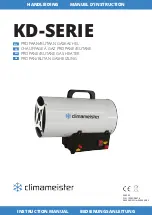
14
no valve or other obstruction is to be placed between the
Temperature-Pressure relief Valve and the tank. Do not connect
discharge piping directly to the drain unless a 6” (15.2 cm)
air gap is provided. To prevent bodily injury, hazard to life, or
property damage, the relief valve must be allowed to discharge
water in adequate quantities should circumstances demand. If
the discharge pipe is not connected to a drain or other suitable
means, the water flow may cause property damage.
Water Damage Hazard
Temperature-Pressure Relief Valve discharge
pipe must terminate at adequate drain.
•
CAUTION
t&p Valve discharge pipe requirements:
• Shall not be smaller in size than the outlet pipe size of the
valve, or have any reducing couplings or other restrictions.
• Shall not be plugged or blocked.
• Shall not be exposed to freezing temperatures.
• Shall be of material listed for hot water distribution.
• Shall be installed so as to allow complete drainage of both
the Temperature-Pressure relief Valve and the discharge
pipe.
• Must terminate a maximum of six inches above a floor
drain or external to the building. In cold climates, it is
recommended that the discharge pipe be terminated at an
adequate drain inside the building.
• Shall not have any valve or other obstruction between the
relief valve and the drain.
Burn hazard.
Hot water discharge.
Keep clear of Temperature-
Pressure Relief Valve
discharge outlet.
The Temperature-Pressure relief Valve must be manually
operated at least twice a year. Caution should be taken to
ensure that (1) no one is in front of or around the outlet of the
Temperature-Pressure relief Valve discharge line, and (2) the
water manually discharged will not cause any bodily injury or
property damage because the water may be extremely hot. If
after manually operating the valve, it fails to completely reset
and continues to release water, immediately close the cold water
inlet to the water heater, follow the draining instructions in this
manual, and replace the Temperature-Pressure relief Valve with
a properly rated/sized new one.
note:
The purpose of a Temperature-Pressure relief Valve is
to prevent excessive temperatures and pressures in the storage
tank. The T&P valve is not intended for the constant relief of
thermal expansion. A properly sized thermal expansion tank must
be installed on all closed systems to control thermal expansion,
see Closed Water Systems and Thermal expansion on page 13.
If you do not understand these instructions or have any questions
regarding the Temperature-Pressure relief Valve call the toll free
number listed on the back cover of this manual for technical
assistance.
ComBustiBle material storage
Fire or Explosion Hazard
Read instruction manual before
installing, using or servicing
water heater.
Avoid all ignition sources if you smell gas.
Do not store or use gasoline or other flammable vapors and
liquids in the vicinity of this or any other appliance.
Use only the gas shown on the water heater rating label.
Keep ignition sources away from faucets after extended
periods of non-use.
Maintain required clearances to combustibles.
Do not expose water heater controls to excessive gas
pressure.
Keep water heater area clear and free of combustible materials,
gasoline and other flammable vapors and liquids.
Contaminated air
Breathing Hazard - Carbon Monoxide Gas
Install water heater in accordance with
the Instruction Manual and NFPA 54 or
CAN/CSA-B149.1.
To avoid injury, combustion and ventilation
air must be taken from outdoors.
Do not place chemical vapor emitting
products near water heater.
Breathing carbon monoxide can cause brain damage or
death. Always read and understand instruction manual.
Corrosion of the flue ways and vent system may occur if air for
combustion contains certain chemical vapors. Such corrosion
may result in failure and risk of asphyxiation.
Combustion air that is contaminated can greatly diminish the life
span of the water heater and water heater components such as
hot surface igniters and burners. Propellants of aerosol sprays,
beauty shop supplies, water softener chemicals and chemicals
used in dry cleaning processes that are present in the combustion,
ventilation or ambient air can cause such damage.
Do not store products of this sort near the water heater. Air which
is brought in contact with the water heater should not contain any
of these chemicals. If necessary, uncontaminated air should be
obtained from remote or outdoor sources. The limited warranty
is voided when failure of water heater is due to a corrosive
atmosphere. (See limited warranty for complete terms and
conditions).















































